Lampang
Lampang (ลำปาoง), also known as Nakhon Lampang (นครลำปาง), is a city in the river valleys of Northern Thailand.
.jpg)
Understand
Lampang, in the Wang River basin, has been occupied by various civilisations, including Hariphunchai, Lanna, and Burmese, for more than 1,000 years and has a rich archaeological record. It is also known for its nostalgic local transport: horse-drawn carriages, rather than tuk-tuks.
Get in
By plane
Lampang Airport (LPT) is served by three daily turboprop (ATR72) flights by Bangkok Airways from/to Bangkok Suvarnabhumi Airport (BKK) at 1.5 hours (1,800 baht and up, includes using their lounge even for the economy class), as well as by three daily flights by Nok Air on a newer and larger Bombardier Q400 turboprop from Don Mueang International Airport (promo fares from 900 baht, November 2014).
Another option is to take a low-cost flight (Air Asia, Nok Air, Thai Lion Air) to Chiang Mai, then connect to Lampang by bus. But it is at least two hours by road from Chiang Mai to Lampang, plus you'll need to connect from the airport to the bus station across (13 km) the entire city.
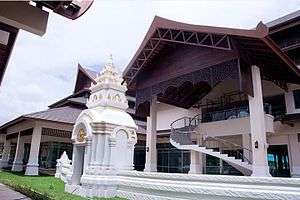
By train
The Northern railway line from Bangkok to Chiang Mai passes through Lampang. As such, there are several trains in either direction every day. The journey from Bangkok takes 10-12 hours; 2nd class air-con sleeper ticket costs 734-804 baht, air-con seat car is 574 baht. 2nd class fan sleeper is 150-200 baht cheaper than air-con.
From Chiang Mai, the trip takes around 2 hours. Express fan car tickets are 23 baht. Air-con car tickets are just over 100 baht.
By bus
Many buses run from Bangkok's Mo Chit terminal, most of which continue on to Chiang Mai. First-class air-con bus ticket costs around 400-450 baht, the trip takes 8-9 hours (as such, overnight buses are recommended).
From Chiang Mai (Arcade bus station), buses are very frequent, and it takes 1-1½ hours to get to Lampang. The price is 40-90 baht, depending on the class (first class air-con bus costs 90 baht)
Finally, many buses going from Chiang Mai to various other destinations in central and northeast Thailand stop in Lampang, so it is pretty well connected.
By car
From Bangkok take Highway 32 to Nakhon Sawan. then Highway 1 via Kamphaeng Phet and Tak to Lampang. Distance from Bangkok is 600 km.
Get around
There are no tuk-tuks, so either use the horse-drawn carriages or the songthaews, which can be hired like a tuk-tuk. If it is not on a fixed route, ask the driver for a price but ensure that you both understand whether the price is for the trip or per person.
See
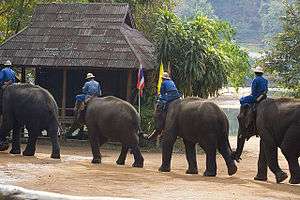
- Ban Sao Nak (Thai: บ้านเสานัก) (House of Many Pillars). An old teak house, Lanna-style with 116 pillars, more than 105 years old. Serves as a museum.
- Chae Son National Park (อุทยานแห่งชาติแจ้ซ้อน), Lampang-Denchai Road (In Mueang Pan District). It is surrounded by a mineral hot spring and rocks. There are many interesting places that are located at Chae Son National Park; for instance, hot spring, Chae Son waterfall, Mae Mon waterfall, Pha-Ngam cave. The most popular place for tourists is Chae Son hot spring where you can cook eggs in 15 minutes. It has a special menu at Chae Son hot spring called "spicy egg salad by mineral hot spring". There is a warm pond near Chae Son hot spring where you can dip your feet and legs. In addition, there are mineral spa rooms where you can take a mineral bath to improve your blood circulation and relieve your stress. It features a lush forested and mountainous region with a 73 °C hot spring over rocky terrain, providing a misty and picturesque scene, particularly in the morning.
- Dhanabadee Ceramic Museum. This museum shows the origin of the local specialism of “chicken ceramic bowl”, and demonstrates their production. The aim of this museum is to conserve the local culture and support those who are interested in ceramics.
- Houses in the old town, Thanon Talat Gao. The old market street runs parallel to the river. This was the business centre of the town. Today you can see houses in the Burmese Lanna style and Chinese businessmen's houses with wooden doors and delicately carved windows.
- Thanon Talat Kao or Thanon Talat Chin or Thanon Khon Doen "Kat Kongta" (ถนนตลาดเก่า หรือ ถนนตลาดจีน หรือ ถนนคนเดิน "กาดกองต้า") is a market next to the pier. In the past, it was a prosperous market. The buildings on both sides of the river bank are a combination of European, Chinese, and Burmese architectural styles. Thanon Khon Doen, "Kat Kongta" presents a local lifestyle of the Kat Kongta community.
- The Khun Tan mountain range, where the Doi Khun Tan National Park (อุทยานแห่งชาติดอยขุนตาล) is located, forms a natural boundary between Lamphun and Lampang Provinces. The Khun Tan Range has deciduous dipterocarp forest and dry evergreen forest on the mountainsides, as well as hill evergreen forests and wide stretches of grasslands combined with pine tree clumps at higher altitudes.
- Chao Pho Pratu Pha Shrine (ศาลเจ้าพ่อประตูผา) - Legend has it that Chao Pho Pratu Pha was a great warrior of the Lampang ruler. He once fought Burmese invaders to block their advance at Pratu Pha and died fighting with his two swords still in his hands and his body still leaning against the hillside. To honour the brave warrior, the people built the shrine which has since become a sacred and revered place of worship.
- Tham Pha Thai National Park (อุทยานแห่งชาติถ้ำผาไท) is between Mueang Lampang and Ngao Districts just off the main highway at km665-666, some 60 kilometres from town.
- Ban Chang Luang (บ้านจ้างหลวง หรือ ศูนย์ศิลปะชุมชนเมืองงาว) is a facility established by Khru Kam-aye Dejduangta (ครูคำอ้าย เดชดวงตา). It has an extensive collection of wood-carvings made by Kru Kam-aye himself and serves as a school to train those intending to become artisans and to provide occupations for the local people.
- Namtok Wang Kaeo (น้ำตกวังแก้ว) is Lampang's largest waterfall.
- Kiu Lom Dam (เขื่อนกิ่วลม) is about 38 kilometres from town.
Elephants
- Thai Elephant Conservation Center (ศูนย์อนุรักษ์ช้างไทย) (km28-29 Lampang-Chiang Mai Hwy, Hang Chat), ☎ +66 54 247871. The proceeds from this government-run centre go toward research and elephant conservation initiatives. The center is home to about 50 domesticated elephants, including the first elephant born from artificial insemination, and six of the 10 royal white elephants. The center hosts three daily elephant shows (200 baht for adults, 100 baht for children) at 10:00, 11:00, and 13:00, lasting about 30-45 minutes. During the show the elephants obey commands of the mahout, traditional logging techniques, painting, and playing instruments. After the show you can feed the elephants treats for 20 baht, and pet and have your picture taken with an elephant. You can also ride an elephant in the riding grounds for 500 baht, visit and feed baby elephants and their mothers in the nursery (free) and see sick elephants being cared for in the elephant hospital (free). You can also watch the mahouts bathe the elephants at 09:40 before the first show, or at 13:40 after the last show. A shuttle bus circles the park or you can walk. The centre also has a museum, a homestay program, and a mahout training program. The centre can be reached by public transport from Chiang Mai Arcade bus terminal (minibus, 1 hour, 70 baht) or Lampang. A good alternative to many of the high-priced for-profit "sanctuaries" around Chiang Mai.
Temples
In the city
- 🌍 Wat Pha Fang (วัดป่าฝาง) (Samam Bin Road). Temple erected in the 19th century with a golden chedi containing reliquaries brought here from Burma. Built during the reign of King Rama IV by Burmese, Wat Pa Fang has a large, glittering gold chedi containing a holy relic brought from Burma around 1906. The extensive Sala Kan Parian (preaching hall) is made entirely of wood with Burmese-style overlapping roofs. Almost across Wat Pa Fang is Wat Chai Mongkhon (วัดไชยมงคล), notable is the kuti (monk's living quarters) which is a white cement building with Burmese-style wooden roof. Inside is housed a bronze Buddha statue of fine workmanship cast in Mandalay, Burma.
- 🌍 Wat Phra Kaew Don Tao (วัดพระแก้วดอนเต้า) (Phra Kaeo Road). It used to be the place where the Emerald Buddha was once enshrined (the statue is now installed in Bangkok). Interesting structures include the large chedi containing the hair of the Lord Buddha, a Burmese-style mondop, an ancient viharn and a museum exhibiting ancient relics of the Lanna era.
- 🌍 Wat Si Chum, Wat Si Chum Road. The temple has a small ceremonial hall in Burmese-style. The temple is the seat of a small community of monks from Burma.
- 🌍 Wat Si Rong Mueang (วัดศรีรองเมือง) (In the western part of the city). A temple erected in Burmese-style in 1905 when the teak wood trade flourished and Burmese traders came into the town. Major architectural works include the viharn made of wood with several overlapping gables in the Burmese style.
- Wat Phra That Mon Phaya Chae (วัดพระธาตุม่อนพระยาแช่) - is on a hillside and it affords a clear view of Lampang. Its most outstanding feature is the long staircase leading to the chedi enshrining a holy relic.
- Wat Phra That Sadet (วัดพระธาตุเสด็จ) - one of Lampang's major sites, it is believed to have been built by Queen Chamthevi some 500 years ago.
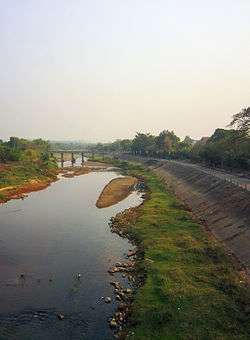
Outside the city
- Wat Chedi Sao Lang (วัดเจดีย์ซาวหลัง) (5 km from the city center on the road to Chae Hom). The temple has 20 white chedis and a statue of Buddha in Burmese-style. Cool and shaded by large trees, the temple has 20 chedis in its compound, each made in the combined Lanna-Burmese style. A Chiang Saen-style bronze Buddha statue is also enshrined here, commonly referred to as "Phra Chao Than Chai" by the local people.
- Wat Phrathat Chom Ping (วัดพระธาตุจอมปิง) (14 km from city center). The amazing aspect of this temple is the natural-coloured reflection of the phrathat passing through the hole of the window and appearing on the floor inside the Phra ubosot all the time when there is light, both during the day and at night.
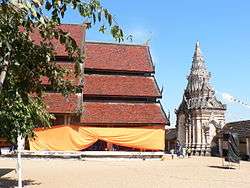
- Wat Phrathat Lampang Luang (วัดพระธาตุลำปางหลวง) (About 12 km from Lampang centre). Traditional Lanna architecture on the site of ancient Lampang city is famous for murals from the 19th century. The city seal features a white cockerel in the temple's gate. A paradigm of temple building of Lanna. The temple itself is prominently sited on a hillock surrounded by walls. The entrance arches, called Pratu Khong (ประตูโขง), is adorned with fine plaster designs. The wall-less main viharn houses a bronze Buddha statue called the Phra Chao Lan Thong (พระเจ้าล้านทอง).
- Wat Chong Khem was completed in 2006 and is the tallest temple in the district. It houses an extensive collection of Buddha images from wood and stone, semi-precious stone such as jade and other semi- and precious metals in glass cabinets the full lengths and breadth of the inner walls.
Do
- Horse carriage ride. 60-200 baht.
Events
- Khantok Chang Fair (งานขันโตกช้าง หรือ สะโตกช้าง), Elephant Conservation Centre. First Friday and Saturday in February. Elephants are fed with fruits and vegetables on the traditional Lanna Tok tablet. There is an elephant show and the pachyderms are feasted with their popular fruits and vegetables which are placed on the tok, a traditional food tray of the Lanna people.
- Luang Wiang Lakhon Fair (งานหลวงเวียงละคอน), Wat Phra Keao Don Tao and Wat Phra Thta Lampang Luang. End of October, beginning of November. Festival related to the history of the city, local customs and traditions. It is held just prior to the annual Loy Krathong featuring Lampang's historical background and long-established customs and traditions. A Khrua Than procession is organized with local people dressed in native attires carrying various traditional household appliances, some of which are of ancient vintage.
- Lampang Trains and Horse Carriages Day (งานวันรถไฟรถม้าลำปาง) is organized at the Nakhon Lampang Railway Station at the beginning of April to commemorate the first royal train that arrived at the station on 1 April 1916. In the event, there will be an exhibition and Kat Mua market, where the participants will dress up in the traditional style of costume of some 80 years ago, when the horse carriage was first used in Lampang. The carriage service is also provided in the event.
- Salung Luang Procession and Songkran Festival (งานแห่สลุงหลวงและสงกรานต์) is the Songkran festival of Lampang, organized from 12–14 April every year. On 12 April, the Salung Luang procession will be beautifully decorated (salung means 'water bowl' and luang means 'large'). The participants in the parade dress up in the ancient Lanna style and carry a giant silver bowl around the city to receive lustral water soaked with turmeric and acacia from the people to be poured onto the Phra Kaeo Don Tao, the revered Buddha image of the town enshrined at Wat Phrathat Lampang Luang. Then, during 13–14 April every year, there will be a merit-making ceremony at the temple, sand pagoda making, ceremony of pouring water onto the elderly, splashing of water, fairs and various forms of entertainment.
Buy
- Handmade Elephant Dung Paper. From the Thai Elephant Conservation Centre.
- Sangchai Outlet. Lampang is a major ceramics centre of Thailand. Up and down Hwy 11 you will find ceramics factories with outlets. An especially good one is Sangchai, which sells a wide range of pottery with the chicken motif along with local goodies such as khao tan biscuits. It's common to see out-of-town Thais shopping for souvenirs.
- Wood carvings (ไม้แกะสลัก) (About 25 kilometres from Lampang town). Wood-carving () is a major industry at Tambon Na Khrua of Mae Tha District. Most local people make their living by producing wooden figures of animals in various sizes. It has been a cottage industry in this locality for generations.
- Sa paper (กระดาษสา). A product made from a type of soft wood. The process is purely traditional and the major producing center is the village of Ban Nam Thong. The Sa is mainly made into parasols, lampshades, decorative flowers and other souvenir items.
- Ka-nom Thai Maipanom (Opposite Lampang Post Office). Legend of Thailand local dessert. You can find any kind of Thai dessert here. Beware! If you buy some desserts that contain some coconut milk, you need to put it in the refrigerator to keep them last longer.
- Kad Tung Kwian Market. Souvenirs, local food, local products, wild food and many more things are available here. This is one of the best markets that you can find in the north of Thailand.
- Hand-made cotton (ผ้าทอมือ) comes in different patterns designed by different villages.
- Terra-cotta or ceramics (เซรามิก) produced in Lampang are of the best quality in Thailand. The indigenous clay, added by the local craftsmanship, has helped to make Lampang the centre of such products, with scores of factories and shops dealing in this craft.
Eat
- Aroy One Baht. Excellent, mainly visited by locals but definitely advisable for tourists.
- Night Market (About a kilometre down the road from the clock tower circle). Many assorted cheap food stalls with tables and seating. On the left at the market entrance is a 7-Eleven that sells (and opens) beer bottles and soft drinks to go with your meal. 50-70 baht per serving.
- Weekend Walking Street (near Riverside Restaurant and Aroy One Baht). On Saturday and Sunday nights, everyone turns out for the walking street.
- Kin Dee. Ranging from Thailand’s local dishes to international dishes, is all available here. Very tasty food, clean and reasonable price. Open from 9:00 am to 9:00 pm everyday.
Drink
- Grandma's Cafe (Corner of Tipchang Rd and Talat Kao). Cosy coffee shop with free Wi-Fi. Drinks, 30-40 baht.
- Introvert (Near Lampang Airport). 10:00-17:00, closed Th. Modern style cafe. Get some refreshing drinks for beginning the fresh new day. Not only delicious drinks, you can also find some lovely desserts or even breakfast and lunch. Highly recommended to taste by yourself, and you will love it forever.
Sleep
| This guide uses the following price ranges for a standard double room: | |
| Budget | less than 500 baht |
| Mid-range | 500-1,500 baht |
| Splurge | over 1,500 baht |
Budget
- Baan Sabaidee, 218 Talad Kao Rd, ☎ +66 54 223612, fax: +66 84 4858482. Wooden colonial house, family-run, clean, great value. 200-600 baht.
- Kim Hotel, 168 Boonyawat Rd, ☎ +66 54 217721, fax: +66 54 226929. Clean rooms, central location. Often full. 330 baht..
- Lampang Guesthouse, ☎ +66 54 231101. Clean rooms, small, nice atmosphere, not many visitors. 200-250 baht..
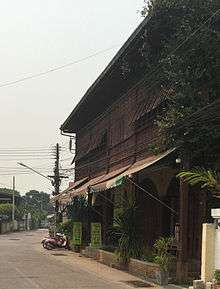
- Riverside Guest House, 286 Talad Kao Rd, ☎ +66 54 227005, fax: +66 54 322342. Often full. Also has good restaurant. 200-1,000 baht.
- 🌍 Tonnam/Tonlux Guesthouse (In front of Riverside Guesthouse on Talad Kao Rd), ☎ +66 839417653. Run by a nice Thai couple. They have a small garden access to the small parking area in front of Please Bar and Gibbon Bar. 250 baht for double with en suite bath and fan, 300 baht with air.
Mid-range
- Asia Lampang Hotel, 229 Boonyawat Rd (Downtown, a few blocks from the Clock Tower), ☎ +66 54 227844. Quite acceptable. From the bus station, a songthaew charges 40-60 baht. The hotel is a little dated, but clean and the air-con is good. The breakfast is a choice of either two Thai dishes of rice porridge or fried noodle, or toast and jam. There is Internet at the hotel, and an Internet cafe is difficult to locate anywhere near the hotel. 540 baht with Thai breakfast.
- Ma Chic & Cozy, 258 Tambon Phrabaht (Near Srichum intersection, Tesco Lotus, and Central Plaza Lampang. From the bus station, a songthaew charges 40 baht per person), ☎ +66 54 011 110, +66 91 068 8686, e-mail: info@ma-lampang.com. Check-in: 13:00, check-out: 13:00. Modern accommodation. Safe, clean rooms and friendly staff. Breakfast buffet 07:00-10:00. Free Internet and welcome drink. 590 baht for a double room. Breakfast 100 baht per person.
- Tipchang Lampang Hotel, 54/22 Takrow Noi Rd, ☎ +66 54 226501-6.
Splurge
- Lampang River Lodge, 330 Moo 11, Tambon Chompoo (South of Lampang between the highway and the Wang River), ☎ +66 54 336640, e-mail: info@lampangriverlodge.com. Cabins in a forested area between a large pond and the river. Safe, clean and friendly staff. Nice swimming pool next to the pond. Standard room 1,850-2,350 baht.
- Wienglakor Hotel, 138/38 Phaholyothin Rd, ☎ +66 54 228095, e-mail: info@lampangwienglakor.com. Charming wooden style hotel. Very well maintained. No buffet breakfast, just a la carte. 1,800+ baht.
Go next
- Hang Chat
- Doi Khun National Park
- Chao Pho Prato Pha Shrine, 50 km from Lampang
- Kiu Lom Causeway
- Tham Pha Thai National Park, 60 km from Lampang
- Ban Chang Luang, woodcarving centre. 33 Mu 9, Ban Khoi, Tamboon Bang Rong, neare the road from Phayao to Lampang
- Chaeo Son National Park, Mueang Pan District
| Routes through Lampang |
| Chiang Mai ← Lamphun ← | N |
→ Uttaradit → Bangkok |
| Chiang Rai ← Phayao ← | N |
→ Tak → Bangkok |